
Rajasthan – Places to Visit
Agra
One of the special highlights of a trip to India is a visit to the former Mughal capital of Agra in the western part of the state of Uttar Pradesh. With the Red Fort and the Taj Mahal, both UNESCO World Heritage Sites, Agra is an impressive tourist highlight. The Mughal Emperor Akbar began in 1565 with the construction of the massive Red Fort. Located directly on the banks of the river Yamuna, it served as a fortress and a palace complex. The world famous Taj Mahal, the very symbol of India, is within sight of the fort. The imposing white marble building stands on a platform surrounded by four minarets in a beautiful garden with an elongated water basin. The Taj Mahal was built by Mughal emperor Shah Jahan as a tomb for his wife Mumtaz Mahal, who died in 1631. The materials to construct it with were brought in from all over India and other parts of Asia. The mausoleum is considered a majestic masterpiece of Indo-Islamic architecture and is often described as the epitome of architectural perfection. The central dome is over 55 meters high. Visitors can admire both the grandeur of the overall design and the extraordinary details of the sculpturing, accentuated by the flower-shaped inlays of semiprecious stones. Inside are the tombs of Mumtaz Mahal and Shah Jahan. The quality of light at different times of day and in different seasons affects the appearance of the Taj Mahal, making it worthwhile to visit more than once.
Bikaner
Bikaner was founded over 500 years ago by Rao Bhikaji, a descendant of the founder of Jodhpur. Located on a trade route, the city was an important trading center in medieval India. Its more than 7 km of circular ramparts with bastions protected its inhabitants from outside attacks. The tourist highlight of Bikaner is the famous Junagarh Fort with its various palaces and its Anup Mahal, richly decorated with stucco, glass, mirror and fine glass work. The historic city center of Bikaner offers insight into the architecture of the extravagant, multi-storey havelis. These spacious traditional houses are built around a central courtyard. The Karna Mata Temple, 33 km away, is dedicated to Karnaji, a mystic of the 15th century, who is regarded as the incarnation of the Goddess Durga.
Bharatpur
Among the other attractions in and around Bharatpur are the Lohagarh Fort and the Keoladeo National Park. The Lohagarh Fort, a massive fortress from the 18th century, is also called the Iron Fort because of its impregnable strength. Several attacks by the British Army were successfully repulsed here, and in 1805 the British had to withdraw after a six-week siege because of severe losses. Lohagarh Fort was built by Maharaja Suraj Mal, who also founded the city. The interesting remains of three palaces (Kishori Mahal, Mahal Khas and Kothi Khas) can be found within the fortress walls. Both the impressive interior design and the exquisite tile patterns in the flooring represent a great combination of Mughal and Rajput architectural style elements.
The Keoladeo National Park used to be known as the Bharatpur Bird Sanctuary and was reserved for hunting by the royal family. With its more than 400 species of birds, the National Park is today rated highly by ornithologists. But the area is well worth a visit, even for the casual visitor. Several species of herons have their habitat here, such as the Purple Heron, the Grey Heron and the Indian Pond Heron. Other bird species present include the painted stork, Eurasian spoonbill, white ibis and gray pelican From October to March, the area is home to about 130 species of migratory birds that arrive from distant lands to winter here. The park is also inhabited by wild boars, mongooses, deer and antelope.
Bundi
The town of Bundi is located in a charming narrow valley next to a steep hill. A palace complex dating from 1600 can be found on a lake with several small islands. To access it, one passes through the impressive Hathi Pol (elephant gate), over the short, steep ramp leading up to it. The complex contains several smaller palaces. Several of the 18th century murals of the Chitra Mahal are considered to be particularly typifying examples of traditional Rajput painting. Towering over the city is the massive Taragarh Fort. Built in the mid-14th century, this quadrangular fort with large corner bastions served as the ruler’s residence until the end of the 16th century. With proper footwear, it can be reached in 20 minutes in a challenging climb. The eastern side is dominated by a gate with high ramparts and battlements; the main gate to the west is flanked by octagonal towers. The central feature of the fort is the Bhim Burj tower, the platform of which once served as the base for the Garbh Ganjam, the big gun. From the fort, one has a wonderful panoramic view of the city, the palace and the surrounding hills.
Chittaurgarh
Chittaurgarh is the largest historic fortress in India and epitomizes the indomitable fighting spirit and legendary pride of the Rajput warriors. The atmosphere of the site, instilled with values such as courage, generosity, sacrifice, glory and honor, gives visitors a sense of the heroic Rajput culture in its heyday. Even today, Rajasthani Hindus who visit Chittaurgarh are awestruck by this masterpiece of Rajput architecture that is regarded by the local population as more of a memorial to Rajput heroes. In the history of this fort, dating back to the 7th century in 72 many thousands of soldiers have lost their lives in the course of three disastrous defeats. Also, three times during the 14th and 16th century, many Rajput women committed Jauhar here, the ritual mass suicide in the holy fire, to avoid dishonor at the hands of their enemies. The climb to the impressive fort goes via a winding road, formerly defended by seven fortress gates. Each turn of the ascending path comes with a legend of a brave warrior who gave his life here in defense of the fort. A remarkable attraction is the 37m high Vijaysthambha, the stone “Tower of Victory”, decorated with exquisite sculptures of Hindu gods and Jain saints and depicting episodes of the Mahabharata and Ramayana.
Delhi
The Indian capital Delhi, the second largest city in the country after Mumbai, can be the starting or end point for tours in Rajasthan. The metropolis, with its astounding collection of temples, mosques, forts, former colonial buildings, densely populated residential areas and busy shopping streets, consists of two urban areas: Old Delhi and New Delhi. This makes it easier for visitors to find their way around the city. Built in the first half of the 17th century, Old Delhi served as the capital of the Mughal dynasty and is dotted with forts and mosques, such as the Red Fort, and the Jami Masjid. New Delhi is characterized by wide streets and embedded parks and was established in 1911 as the capital by the British. A much-visited hub is Connaught Place, with its cafes, restaurants and shops.
Deogarh
Deogarh is a small town that is popular and pleasant, with a bazaar known particularly for its range of textiles and silver jewelry. The magnificent Deogarh Palace distinguishes itself by its wall paintings, which illustrate the local art of miniature painting. The current Ragar (ruler) is a renowned art historian. Nearby Lake Raghosagar forms an ideal habitat for many migratory bird species.
Fatehpur Sikri
Fatehpur Sikri, a former capital of the Mughal Empire, lies 40 km to the southwest of Agra in Uttar Pradesh and due to its location and importance, is often an integral part of a trip to Rajasthan. Fatehpur Sikri was constructed between 1569 and 1585 by the Mughal Emperor Akbar but was abandoned as soon as 1600 due to persistent water shortages. The city, a UNESCO World Heritage Site, presents itself with an impressive combination of Islamic and Hindu style elements. Within the royal palace is the spacious Diwan-i-Am, a courtyard for public audiences, and next to it rises the Diwan-i-Khas, the area for private audiences, a two-storey building with corner kiosks. Inside is a single room with a circular throne platform from which Akbar led discussions with followers of various religions, seated hidden behind ornate partitions. The foot of the throne’s pillar is decorated with Islamic, Hindu, Christian and Buddhist motifs in four sections. Other attractions include the Dawlat Khana (the artistically designed private rooms of the ruler), the Palace of Birbal, his Grand Vizier, the Jami Masjid, the grave of Sheikh Salim Chishti and the 54 m high Buland Darwaza, erected in 1576 to commemorate the victory over Gujarat. The Palace of Jodhbai, which dominates the harem complex, also has a blend of Hindu and Islamic style elements and is decorated with the tulip motif characteristic of Fatehpur Sikri.
Jaipur
 Jaipur, the “Pink City” of Rajasthan, was conceived in 1727 as the new capital of the Principality of Jaipur, in a remarkable architectural completeness. The name “Pink City” refers to the old, northeastern part of the city, offering not only magnificent palaces but also a number of temples with architecture representative of the styles of several centuries. The pink color of the walls is the outstanding feature here. In Rajasthan, it is regarded as the color of hospitality. The traditional houses, also known as havelis, are three-to five-story buildings set around a shaded courtyard. The bazaar has separate areas for different lines of trade. The famous jewelers of Jaipur are also found here, offering the best selection of semi-precious stones and silver jewelry. Other attractions include the city palace of the ruler Jai Singh, the observatory and the Ram Niwas garden. An absolute highlight is the Hawa Mahal, or “Palace of Winds”, built in 1799 to enable the women of the court to see the street processions without being seen themselves. The five-storey facade is charmingly designed with decorative latticework on windows and balconies.
Jaipur, the “Pink City” of Rajasthan, was conceived in 1727 as the new capital of the Principality of Jaipur, in a remarkable architectural completeness. The name “Pink City” refers to the old, northeastern part of the city, offering not only magnificent palaces but also a number of temples with architecture representative of the styles of several centuries. The pink color of the walls is the outstanding feature here. In Rajasthan, it is regarded as the color of hospitality. The traditional houses, also known as havelis, are three-to five-story buildings set around a shaded courtyard. The bazaar has separate areas for different lines of trade. The famous jewelers of Jaipur are also found here, offering the best selection of semi-precious stones and silver jewelry. Other attractions include the city palace of the ruler Jai Singh, the observatory and the Ram Niwas garden. An absolute highlight is the Hawa Mahal, or “Palace of Winds”, built in 1799 to enable the women of the court to see the street processions without being seen themselves. The five-storey facade is charmingly designed with decorative latticework on windows and balconies.
Jaisalmer
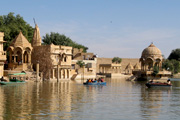 The alluring desert city of Jaisalmer abounds in ancient palaces, temples and beautifully crafted homes. It is also called the “Golden City” because at sunset, its sandstone buildings reflect the light in a particularly evocative manner. A visit to Jaisalmer is associated with a stroll through the winding streets, between bright honey-toned building facades adorned with decorative latticework and flower designs. The architecture of the multi-storey, extravagant havelis is of outstanding quality and well worth seeing. Another highlight is Jaisalmer Fort, a medieval fortress surrounded by ramparts, towering over the desert landscape like a fairytale castle. An ancient palace and several temples form part of the fort. A special attraction is the Jain temple, built between the 12th and 15th century. Its walls, ceilings and pillars are adorned with exquisite sculptures.
The alluring desert city of Jaisalmer abounds in ancient palaces, temples and beautifully crafted homes. It is also called the “Golden City” because at sunset, its sandstone buildings reflect the light in a particularly evocative manner. A visit to Jaisalmer is associated with a stroll through the winding streets, between bright honey-toned building facades adorned with decorative latticework and flower designs. The architecture of the multi-storey, extravagant havelis is of outstanding quality and well worth seeing. Another highlight is Jaisalmer Fort, a medieval fortress surrounded by ramparts, towering over the desert landscape like a fairytale castle. An ancient palace and several temples form part of the fort. A special attraction is the Jain temple, built between the 12th and 15th century. Its walls, ceilings and pillars are adorned with exquisite sculptures.
Jodhpur
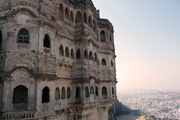 This city, which became well known through its eponymous tight-fitting trousers, worn by riders, was built on sandy terrain near the Thar desert. It was once a center for the rulers of Marwar. Life in Jodhpur revolves around Mehrangarh Fort in the historic city center, a tourist attraction with palaces, museums, warehouses, hotels and shops, offering colorful Rajasthani attire decorated with mirrors and embroidery. The bazaar has separate areas for different lines of trade. Locally produced goods range from batiks to dolls and silver jewelry. In Rajasthan, Jodhpur is also known as the blue city. The historic city center, in particular, is dominated by the color blue. The custom traces its origin to houses that were painted this color by Brahmins. In the course of time, this preference has spread further and today, the color blue can even be seen on mosques and other buildings. The spectacular fort, which offers a beautiful view of the city, includes Jhanki Mahal, Moti Mahal, Phool Mahal and other palaces adorned with decorative latticework.
This city, which became well known through its eponymous tight-fitting trousers, worn by riders, was built on sandy terrain near the Thar desert. It was once a center for the rulers of Marwar. Life in Jodhpur revolves around Mehrangarh Fort in the historic city center, a tourist attraction with palaces, museums, warehouses, hotels and shops, offering colorful Rajasthani attire decorated with mirrors and embroidery. The bazaar has separate areas for different lines of trade. Locally produced goods range from batiks to dolls and silver jewelry. In Rajasthan, Jodhpur is also known as the blue city. The historic city center, in particular, is dominated by the color blue. The custom traces its origin to houses that were painted this color by Brahmins. In the course of time, this preference has spread further and today, the color blue can even be seen on mosques and other buildings. The spectacular fort, which offers a beautiful view of the city, includes Jhanki Mahal, Moti Mahal, Phool Mahal and other palaces adorned with decorative latticework.
Kumbhalgarh
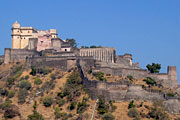 Kumbhalgarh was the second most important fort in the Mewar kingdom, after Chittaurgarh. Built in the mid-15th century by Maharana Bhumba, it lies in a strategically important position on the border between Udaipur (Mewar) and Jodhpur (Marwar) in the western foothills of the Aravalli Range. The facility is surrounded by a 36 km long, 12 m high and 8 m thick wall with massive watchtowers and semi-circular bastions that could withstand long sieges. Within these walls there are numerous buildings spread out among several hills, water wells, stables, secret passages and arsenals. Just the temple complexes alone comprise 360 temples. The upper floors of the former palace offer a picturesque view of the idyllic surrounding landscape. To the west of the fort is the Kumbhalgarh Wildlife Sanctuary, a protected nature reserve with leopards, sloths, sambar deer, hyenas, giant squirrels, crocodiles and a variety of birds. On of the national park’s particularly successful programs has been the repopulation of endangered wolves.
Kumbhalgarh was the second most important fort in the Mewar kingdom, after Chittaurgarh. Built in the mid-15th century by Maharana Bhumba, it lies in a strategically important position on the border between Udaipur (Mewar) and Jodhpur (Marwar) in the western foothills of the Aravalli Range. The facility is surrounded by a 36 km long, 12 m high and 8 m thick wall with massive watchtowers and semi-circular bastions that could withstand long sieges. Within these walls there are numerous buildings spread out among several hills, water wells, stables, secret passages and arsenals. Just the temple complexes alone comprise 360 temples. The upper floors of the former palace offer a picturesque view of the idyllic surrounding landscape. To the west of the fort is the Kumbhalgarh Wildlife Sanctuary, a protected nature reserve with leopards, sloths, sambar deer, hyenas, giant squirrels, crocodiles and a variety of birds. On of the national park’s particularly successful programs has been the repopulation of endangered wolves.
Mandawa (Shekhawati region)
The Shekhawati region north of Jaipur has great scenic and cultural charm. The name of this desert border area dates back to the Rajput ruler Shekhaji Rao, who founded a principality here in the 15th century. The special attraction of this area is the frescoed architecture, the only of its kind in India. A considerable number of houses, palaces and monuments are decorated with elaborate murals in vivid colors. The themes comprise arabesques with flower patterns and birds, ethnic motifs and scenes from the Indian epics as well as designs with a European touch. The opulent residences and commercial buildings of the Marwaris, as the inhabitants of the region are called, are especially adorned with the detailed murals. The Marwaris came to considerable prosperity as enterprising merchants from 1770 to 1930, trading in gold, jewelry, carpets, spices and silk. By constructing spacious houses, the so-called havelis, they gave expression to their newfound status and tried to outdo one another. The magnificent havelis are privately owned and many are still inhabited. Sometimes, upon request, one can be granted a look at the beautiful interior of these houses.
Mount Abu
The especially scenic small town of Mount Abu is the only hill station in Rajasthan. The popular holiday destination was named after the mountain it rests on, which has mythological significance. Mount Abu is one of Jainism’s most important pilgrimage sites. It is known for its great marble Jain temple, which was built between the 10th and 13th century in Dilwara in beautiful surroundings replete with mango trees and green hills. The complex, consisting of five main temples, is surrounded by a bright white wall. The Vimal Vasahi and Luna Vasahi Temples, which may appear rather unassuming from the outside, are among the most impressive architectural masterpieces in India. The elaborate interior design is of such exquisite quality that, at first glance, it seems as if one is looking at papercut designs. In places, the marble is carved so thin and fine that it becomes translucent. Mount Abu is also the spiritual headquarters of the Brahma Kumaris, a religious community based on Hinduism and represented in more than 70 countries. A scenic highlight of the region is Nakki Lake, whose lakeside path leads past beautiful rock formations.
Pushkar
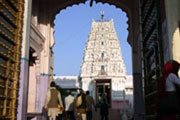 The pilgrim town of Pushkar is among the most important religious sites in India, with winding streets that run through a narrow valley dominated by impressive cliffs. Its primary attraction is the only temple in India dedicated to Brahma, the creator of the world. The 14th century shrine, which is visited by pilgrims throughout the year, has a special sanctity as tradition holds that Brahma took incarnation at this spot. According to legend, the temple originated from a lotus flower that the Hindu god, riding on the wild goose Hamsa, dropped to the floor while looking for a suitable place to perform a sacrifice. Apart from the Brahma temple, there are about 400 smaller temples in the city. On the 52 ghats on Pushkar Lake, pilgrims take their ritual baths in one of India’s most sacred water bodies. Another attraction is the Camel Fair. Held at the end of October or the beginning of November, the Pushkar Mela, a camel market and popular festival type event, hosts over 200,000 visiting tourists, pilgrims, farmers, camel breeders and traders. The place takes on a colorful carnivalesque atmosphere for the duration of the festival.
The pilgrim town of Pushkar is among the most important religious sites in India, with winding streets that run through a narrow valley dominated by impressive cliffs. Its primary attraction is the only temple in India dedicated to Brahma, the creator of the world. The 14th century shrine, which is visited by pilgrims throughout the year, has a special sanctity as tradition holds that Brahma took incarnation at this spot. According to legend, the temple originated from a lotus flower that the Hindu god, riding on the wild goose Hamsa, dropped to the floor while looking for a suitable place to perform a sacrifice. Apart from the Brahma temple, there are about 400 smaller temples in the city. On the 52 ghats on Pushkar Lake, pilgrims take their ritual baths in one of India’s most sacred water bodies. Another attraction is the Camel Fair. Held at the end of October or the beginning of November, the Pushkar Mela, a camel market and popular festival type event, hosts over 200,000 visiting tourists, pilgrims, farmers, camel breeders and traders. The place takes on a colorful carnivalesque atmosphere for the duration of the festival.
Ranakpur
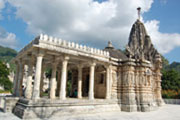 Ranakpur, located in a remote valley, boasts one of the largest and most important Jain temples in India. The site, known for its grandiose architecture and lavish ornamentation, was built in 1439 and is considered a masterpiece of the West Indian architectural style. Some parts of the temple are two or three stories high. The roof is designed with five Sikharas (tower-like structures in the temple architecture of North India). The interior features 29 halls. Some of them are octagonal, while others extend over several floors. They are supported by a total of 1444 pillars, each one with a unique ornamental design. The lacy decorations on the vaulted roof are of exquisite quality and combine the highest aesthetic standards with understated elegance. The temple is dedicated to Adinath, the first of the 24 Tirthankaras (“ford-Maker”) of the Jain religion. Its four-faced image can be viewed in the sanctum of the Chaumukha shrine. The Jains, who meditate in the open hall before the statue, do not revere him as a God but hold him up as an example. In the vicinity of the complex are two smaller Jain temples, dedicated to the Tirthankaras Parshvanath and Neminath, and a Hindu temple dedicated to the sun god Surya. The Parshvanath Temple has a statue of the 23rd Tirthankara made of black stone, with a multi-headed cobra towering over his head. The walls are richly decorated with sculptures, including delicate erotic figures. Especially noteworthy in the Surya Narayana Temple is the portrayal of the sun god Surya in his carriage, drawn by seven horses.
Ranakpur, located in a remote valley, boasts one of the largest and most important Jain temples in India. The site, known for its grandiose architecture and lavish ornamentation, was built in 1439 and is considered a masterpiece of the West Indian architectural style. Some parts of the temple are two or three stories high. The roof is designed with five Sikharas (tower-like structures in the temple architecture of North India). The interior features 29 halls. Some of them are octagonal, while others extend over several floors. They are supported by a total of 1444 pillars, each one with a unique ornamental design. The lacy decorations on the vaulted roof are of exquisite quality and combine the highest aesthetic standards with understated elegance. The temple is dedicated to Adinath, the first of the 24 Tirthankaras (“ford-Maker”) of the Jain religion. Its four-faced image can be viewed in the sanctum of the Chaumukha shrine. The Jains, who meditate in the open hall before the statue, do not revere him as a God but hold him up as an example. In the vicinity of the complex are two smaller Jain temples, dedicated to the Tirthankaras Parshvanath and Neminath, and a Hindu temple dedicated to the sun god Surya. The Parshvanath Temple has a statue of the 23rd Tirthankara made of black stone, with a multi-headed cobra towering over his head. The walls are richly decorated with sculptures, including delicate erotic figures. Especially noteworthy in the Surya Narayana Temple is the portrayal of the sun god Surya in his carriage, drawn by seven horses.
Ranthambore
The Ranthambore National Park is the most famous tiger reserve in Rajasthan. The extensive 410 km² wildlife reserve, which served as the hunting ground of a Maharaja until 1970, starts ten kilometers from the small town of Sawai Madhopur. Bordered by dry forests, it stretches across rocky hills and an open valley with small ponds and fruit trees at the eastern foothills of the Aravalli and Vindhya Ranges. The Ranthambore National Park is one of the most appealing wildlife reserves in the world. It gets its special atmosphere from the majestic ruins of a 10th century fortress located within the National Park, rising majestically above the reserve on a 215 meter high rock. Interspersed along the old fortress wall are several semi-circular bastions. The landscape is characterized by breathtaking views and steep rock formations. The park is home to tigers, leopards, hyenas, jackals, jungle cats, crocodiles, wild boars, bears, several deer species, antelope, honey badgers, mongooses and a multitude of bird species. A safari in Ranthambore National Park is an unforgettable experience.
Shekhawati
Shekhawati North of Jaipur lies Shekhawati, a region with great scenic charm. Both the architecture and the ornamental paintings that adorn the walls of local buildings are extraordinary and can be found nowhere else in India. A considerable number of houses, palaces and cenotaphs are covered in detailed murals with vibrant colors, created between 1770 and 1930. The unusual aspect of these murals is that they were not commissioned by the Maharaja or any religious institution, but by the Marwaris, the merchants of the region. Most of the buildings are privately owned and many are in fact inhabited. On request, one might be granted the opportunity to appreciate the beautiful interiors of these houses.
Sikandra
The small town of Sikandra is in the Indian state of Uttar Pradesh, 10 km north of Agra, on the road to Delhi. Due to its ideal location, it is often included in tours around Rajasthan. The main attraction of Sikandra is the grandiose tomb of the Mughal emperor Akbar. The mausoleum, commissioned by the ruler three years before his death, was completed in 1613 by his son Jahangir. Situated in a quiet garden, the architectural design of the tomb is an excellent example of the combination of different styles. The magnificent main entrance, the use of ornamental motifs and Persian calligraphy, the decorative cutout patterns of the walls and windows, the artistically designed garden and the four multi-storey minarets are testament to the prevailing Islamic influence. The remains of the ruler are kept in a simple marble sarcophagus downstairs.
Udaipur
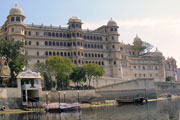 The city of Udaipur at Lake Pichola expresses the magic of Rajasthan in particularly picturesque and evocative ways. On the banks of the artificial lake, marble palaces rise up, a brightly glistening white in the sunlight. Further sumptuous palaces, converted to luxury hotels, are located on two islands. The crowning glory of the palaces in Udaipur is the City Palace, in which the full splendor of the Orient is on display. Until 1956, it served as the seat of government for the Maharanas of Mewar and it is the largest palace complex in Rajasthan. The walls of the residence of the former ruler are adorned with mosaics opulently decorated by peacock motifs. The floors are inlaid with precious tiles. The palace is crowned by balconies, towers and domes and offers fabulous panoramic views from its upper terraces and roof gardens. Much of the complex is now a museum with a representative collection of miniatures, mirror work and ornamental tiles. Below the palace entrance is the impressive Sri Jagdish Temple, the largest Jain temple in Udaipur. We also recommend a visit to Shilpgram, an area outside the city center designated for the promotion of traditional arts and crafts. The exhibition is not limited to Rajasthan, but extends to folk art from Gujarat, Goa and Maharashtra.
The city of Udaipur at Lake Pichola expresses the magic of Rajasthan in particularly picturesque and evocative ways. On the banks of the artificial lake, marble palaces rise up, a brightly glistening white in the sunlight. Further sumptuous palaces, converted to luxury hotels, are located on two islands. The crowning glory of the palaces in Udaipur is the City Palace, in which the full splendor of the Orient is on display. Until 1956, it served as the seat of government for the Maharanas of Mewar and it is the largest palace complex in Rajasthan. The walls of the residence of the former ruler are adorned with mosaics opulently decorated by peacock motifs. The floors are inlaid with precious tiles. The palace is crowned by balconies, towers and domes and offers fabulous panoramic views from its upper terraces and roof gardens. Much of the complex is now a museum with a representative collection of miniatures, mirror work and ornamental tiles. Below the palace entrance is the impressive Sri Jagdish Temple, the largest Jain temple in Udaipur. We also recommend a visit to Shilpgram, an area outside the city center designated for the promotion of traditional arts and crafts. The exhibition is not limited to Rajasthan, but extends to folk art from Gujarat, Goa and Maharashtra.
